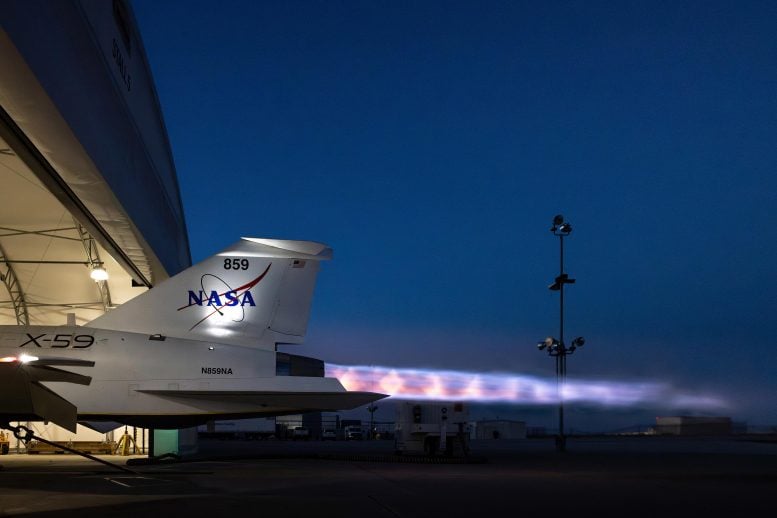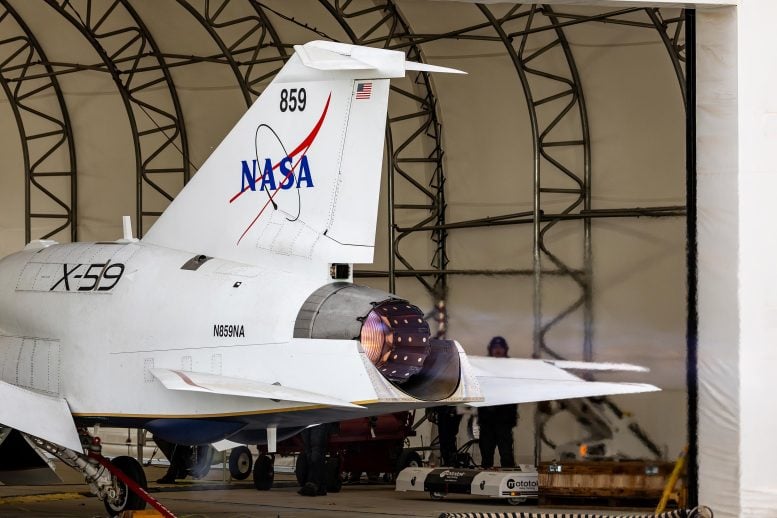
<span class="glossaryLink" aria-describedby="tt" data-cmtooltip="
” data-gt-translate-attributes=”[{"attribute":"data-cmtooltip", "format":"html"}]” tabindex=”0″ role=”link”>NASA’s X-59 has cleared another hurdle with the successful completion of critical engine tests. The trials confirmed that its F414-GE-100 engine, adapted from the F-18 Super Hornet, performs as expected at full power.
The aircraft’s design, including its unique top-mounted engine and elongated nose, aims to soften sonic booms to a mere “thump.” As NASA prepares for the first flight, additional tests will ensure the aircraft is ready for safe operation.
Engine Tests Mark a Major Milestone
NASA’s X-59 quiet supersonic research aircraft has reached another milestone on its path to flight, successfully completing a series of engine performance tests.
In preparation for the X-59’s first planned flight this year, NASA and Lockheed Martin conducted and completed engine run tests in January. The aircraft is powered by a modified F414-GE-100 engine, which also supports its integrated subsystems. Over the course of three increasingly complex tests between October and January, the engine met performance expectations at Lockheed Martin’s Skunk Works facility in Palmdale, California.
“We have successfully progressed through our engine ground tests as we planned,” said Raymond Castner, X-59 propulsion lead at NASA’s Glenn Research Center in Cleveland. “We had no major showstoppers. We were getting smooth and steady airflow as predicted from wind tunnel testing. We didn’t have any structural or excessive vibration issues. And parts of the engine and aircraft that needed cooling were getting it.”
[embedded content]
In preparation for the X-59’s planned first flight this year, NASA and Lockheed Martin successfully completed the aircraft’s engine run tests in January. Testing included electrical, hydraulics and environmental control systems. Credit: NASA Glenn Research Center
Pushing the Limits: High-Power Testing
The tests began with seeing how the aircraft’s hydraulics, electrical, and environmental control systems performed when the engine was powered up but idling. The team then performed throttle checks, bringing the aircraft up to full power and firing its afterburner – an engine component that generates additional thrust – to maximum.
A third test, throttle snaps, involved moving the throttle swiftly back and forth to validate that the engine responds instantly. The engine produces as much as 22,000 pounds of thrust to achieve a desired cruising speed of Mach 1.4 (925 miles per hour) at an altitude of approximately 55,000 feet.
The X-59’s engine, similar to those aboard the U.S. Navy’s F-18 Super Hornet, is mounted on top of the aircraft to reduce the level of noise reaching the ground. Many features of the X-59, including its 38-foot-long nose, are designed to lower the noise of a sonic boom to that of a mere “thump,” similar to the sound of a car door slamming nearby.

What’s Next Before Takeoff?
Before its first flight, the X-59 will undergo several key tests. Engineers will assess the aircraft for potential electromagnetic interference and conduct “aluminum bird” testing, where data is fed into the aircraft under both normal and failure scenarios. Additionally, a series of taxi tests and final preparations will take place to ensure the aircraft is ready for takeoff.
The X-59 is the centerpiece of NASA’s Quesst mission, which aims to overcome one of the biggest challenges in commercial supersonic travel — reducing the disruptive noise of sonic booms to a quieter, more manageable level.
